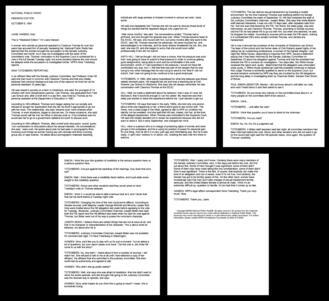Nina Totenberg
Today we think of the Clarence Thomas/Anita Hill hearings as a watershed in American political and social life. But as I walked into the Russell Senate Office Building in the early hours of October 11, 1991, I had no notion of what those hearings would come to mean. The story at that moment was nothing more to me than Clarence Thomas, Round II of the confirmation process. To my astonishment, though, the building was not its usual quiet self. Cables, lights, cameras were everywhere. My mouth literally fell open as I recognized that the story I had broken just a few days earlier had turned into a mega-story.
It was a story I had been working on ever since I had learned that Anita Hill had informed the Judiciary Committee of her charges in early September, before the first round of Thomas hearings began. I eventually determined that the chairman of the committee, Joseph Biden, had not pursued the charges initially – had not even talked to Anita Hill, on the grounds that if she was not willing to go public, he would not investigate. Only at the 11th hour, with the first round of hearings over, did Biden finally succumb to pressure from some Democrats. But the investigative step he took was minimal: he asked the White House to have Hill and Thomas each interviewed by the FBI. There was no follow-up, no further investigation.
As I began to dig for facts, it seemed to me that the story was not just Anita Hill and Clarence Thomas, but the story of the Judiciary Committee and how it did its job. And even after my October 6th broadcast, the Senate seemed little interested in pursuing the Hill allegations. It was only after the phone lines jammed and the fax machines were nearly vaporized that the body politic began to realize that these were charges that, true or not, could not be ignored.
Less than a week earlier, after many difficult conversations, I had finally told Professor Hill that I had a copy of her affidavit charging Supreme Court nominee Clarence Thomas with sexual harassment. It was only then that she resolved her ambivalence and agreed to an interview. It lasted about a half hour. And what is remarkable is how little had changed about her charges, and how little evidence the beleaguered Senate Judiciary Committee managed to collect as it stumbled and smashed its way through three days of tumultuous testimony.
The Senate had held hearings with no thought, planning, rules, or investigation, and the Senate had resolved nothing. Clarence Thomas was confirmed by a two-vote margin, but women voters rebelled – first ousting Illinois Democrat Alan Dixon, one of the only 11 Democrats to have voted for Thomas. Dixon was beaten in a primary by Carol Moseley-Braun, a little known Cook County official with almost no campaign money, who decided to get into the race because of her outrage at the Hill/Thomas hearings. She would become the first of four new women to win Senate victories in 1992.
The hearings ripped open the subject of sexual harassment like some sort of long-festering sore. It oozed over every workplace, creating everything from heated discussions to an avalanche of lawsuits. In 1992, the number of sexual harassment charges filed through the Equal Employment Opportunity Commission and Fair Employment Practices Agencies had increased by nearly 72% from the number of charges brought in 1990.
In short, the Clarence Thomas/Anita Hill controversy has become the Alger Hiss case of our times. Hill and Thomas partisans in the thousands can and do debate the minutiae of every witness’s testimony, pro and con. True believers on both sides would probably argue that for good or ill, the hearings spurred political and cultural revolution across the country.
As adapted from: The Complete Transcripts of the Clarence Thomas-Anita Hill Hearings: October 11, 12, 13, 1991, by Nina Totenberg
Paperback (ISBN: 0897334086)
Date Published: 09/01/1994 (published by Academy Chicago Pub)
Editor: Anita Miller
Nina Totenberg is National Public Radio’s award-winning legal affairs correspondent. Her reports air regularly on NPR’s critically acclaimed newsmagazines All Things Considered, Morning Edition, and Weekend Edition. She is also a regular panelist on Inside Washington, a weekly syndicated public affairs television program produced in the nation’s capital. Totenberg’s coverage of the Supreme Court and legal affairs has won her widespread recognition. In 1991, her ground-breaking report about University of Oklahoma Law Professor Anita Hill’s allegations of sexual harassment by Judge Clarence Thomas led the Senate Judiciary Committee to re-open Thomas’s Supreme Court confirmation hearings to consider Hill’s charges. That coverage earned Totenberg numerous awards, including the prestigious Joan S. Barone Award for excellence in Washington-based national affairs/public policy reporting. A frequent contributor to major newspapers and periodicals, she has published articles in The New York Times Magazine, The Harvard Law Review, The Christian Science Monitor, Parade Magazine, New York Magazine, and others.





